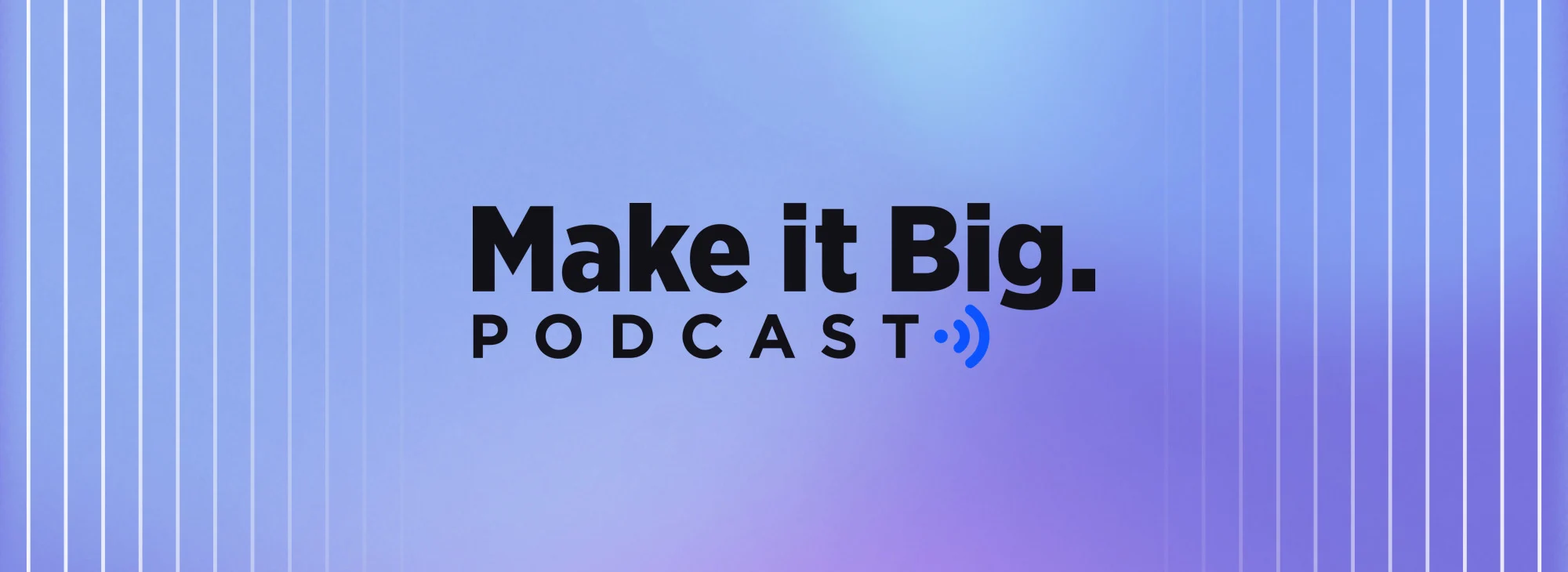
Ecommerce insights on the go
Tune in to the Make it Big Podcast — our thought leadership audio series for retailers, entrepreneurs and ecommerce professionals. You'll get expert insights, strategies and tactics to help grow your business.

Make it Big Podcast: The Current and Future State of B2B Ecommerce


Make it Big Podcast: The Current and Future State of B2B Ecommerce
Get The Print Version
Tired of scrolling? Download a PDF version for easier offline reading and sharing with coworkers.
A link to download the PDF will arrive in your inbox shortly.
Welcome to The Make it Big Podcast, a bi-weekly audio series about all things ecommerce by BigCommerce.
In this episode, we explore emerging trends to carry your B2B business into the future. Mira Commerce’s President and CEO Sergei Ostapenko joins BigCommerce Product Marketing Manager Fiona Norton to discuss the findings from BigCommerce’s recent The State of B2B Ecommerce 2022 Trend Report and how B2Bs are leveling up their ecommerce experiences.
All episodes of The Make it Big Podcast are now available on Spotify, Apple and Google.
The Make it Big Podcast: Episode 18
Fiona Norton: Tell us about today’s B2B businesses. Which industries are seeing the most success in selling B2B online and where are we seeing the most growth?
Sergei Ostapenko: “Interestingly, I recall that back in 2019, Forrester predicted that the share of B2B transactions online was going to be just 17% in 2023 — and look at what we have today. Over half of B2B businesses do online shopping, and it’s revolutionary. It’s really amazing how far we’ve gone in just these few years.
“What we are seeing is that in the B2B space, businesses in verticals like healthcare and those in wholesale distribution like automotive, aftermarket parts and accessories, industrial supplies, and parts of all kinds, these businesses continue to streamline those B2B cross-channel sales efforts and are building out their B2B channels even further.
“We’ve seen a lot of new site overhauls, new channel launches, and a lot of custom application builds. But most importantly, I think what we’ve seen in 2020 and 2021 is the major shift in the SMB and mid-market space, where companies are finally streamlining their retail and wholesale channels online. They bring that B2B channel into the digital fold, utilizing and enhancing the retail site investments for powering B2B use cases as well.”
FN: What about the buyer side? What makes today’s B2B buyers different from B2B buyers of the past?
SO: “This is actually the most exciting part of this transformation to see, Fiona. The B2B buyers are way younger than those even a few years ago. They’re mobile, self-sufficient, utilizing chat messaging and click-to-call functionalities. It’s no longer an old friends club.
“Secondly, they have legacy-free mindsets. A digital self-service model is very well perceived by them. They’re less tolerant of your marketing and sales disconnects, and we actually see an adverse learning model. It’s young training old, not old training young as it used to be.
“[B2B] buyers prefer digital discovery to talking with sales reps, and they’re quite mobile, always shifting between physical and digital.”
“There’s an expectation of the seamless experience they have with B2C sites and with Amazon experiences that they also want from the B2B sites. They are always quickly researching the products, self-educating, and only interacting with you if they need to.
“If I were to summarize, I would say that a modern seller to B2B buyers must be digitally adept, and he or she will need to share deep insights with these buyers. They need to engage in this potential solution creation with the buyer rather than just take the orders from them.”
FN: How are you seeing B2Bs harness the power of headless commerce to create these unique experiences?
SO: “Headless is on the rise, but just to make sure that everybody remembers the fundamental definition: Headless commerce is an ecommerce architecture where you decouple the front end of your website from your backend shopping cart, ecommerce platform, and functionality. So, you can update, edit or customize your backend without interfering with the front end of your site.
“It’s opening up a lot of possibilities for the merchants. That architecture can be leveraged in so many ways. You can implement custom business rules. You can integrate with systems seamlessly. You can build your custom integrations in a flexible way. You can deploy additional custom applications in the cloud or into your shopping cart and bring them to the storefront experience.
“It allows you to stay outside of any single vendor solution to really enable those plug-and-play type functionalities for different systems of record in your ecosystem. You can enrich your B2B buyer profiles and personas, and market to them in a meaningful way, creating that ‘wow’ effect.”
FN: Over a third of B2B businesses have an equal focus on selling B2B and B2C. How are companies tackling selling both B2B and B2C online?
SO: “In the most common scenario, one can set up separate customer groups for both B2C and B2B on the website with group-specific pricing categories and products. In many cases, this is sufficient to enable the basic core B2B shopping, but it only works for the simplest of cases. It’s a nice, elegant way to deploy a B2B experience on your B2C site, leveraging your investment and using the same instance of it to power both experiences.
“However, as you add more complex cases – as you scale your B2B business and have various members of your supply chain shopping there – you need to enable complex scenarios such as promotions, bundling and so forth.
“Most platforms either have great B2B extensions on versions of themselves, or it’s also an opportunity for you to consider headless implementation where you can build custom experiences for the B2B buyers and deploy custom storefronts for them. So that’s how they may tackle some of these challenges and opportunities.
“We see a lot of innovation in this space, especially in the last year with mid-market merchants who are seeing the opportunity finally materialize, and so much more podium has shifted online in these B2B transactions.”
FN: What’s one word that you would use to describe the future of B2B ecommerce?
SO: “Well-integrated. I think that’s the trend we are seeing. The orchestration between different channels, and orchestration of that user experience. Following [customers] in their journey, especially post-purchase.
“Understanding all the touch points with your brand, and understanding their needs, their context, what their business needs to succeed. That cannot happen without integrating that B2B buying experience into your various other streams of digital inside your organization…
“That digital thread it’s no longer about the shopping cart. It’s no longer about the headless versus all-in monolithic. It’s not about decoupled experiences.
“It’s about a digital thread in which you weave all these data points and experiences. They have the touchpoints, and you integrate all of that into this beautiful, well-composed experience for users.”
For even more B2B insights, explore our full The State of B2B Ecommerce Report, and be sure to check out more episodes of The Make it Big Podcast on Spotify, Apple and Google.

Krystin Gresham is a Content Marketing Manager at BigCommerce where she focuses on thought leadership content. Krystin holds a BBA in Marketing from Texas A&M University. With a background in both retail and tech, Krystin enjoys staying up on the latest retail and technology trends in the ecommerce industry. When she's not crafting content, Krystin enjoys traveling with her husband and volunteering with the Junior League of Austin.


